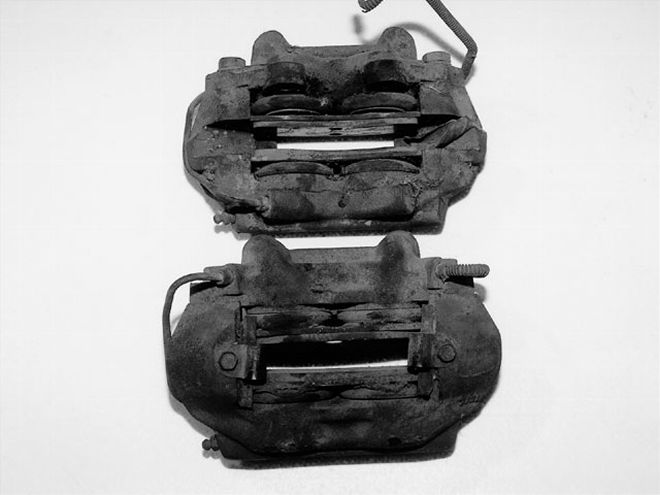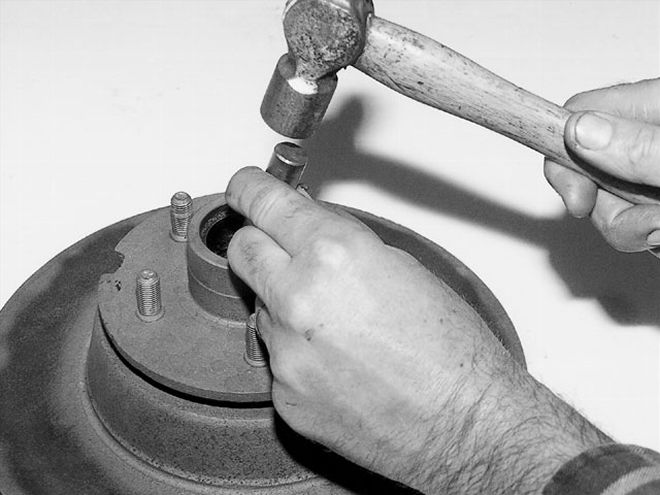
 The heart of our brake resto effort was sending the rusty, worn-out A-Body four-piston calipers to Master Power Brakes for the full treatment. The calipers come back nicer than new and ready to run.
The heart of our brake resto effort was sending the rusty, worn-out A-Body four-piston calipers to Master Power Brakes for the full treatment. The calipers come back nicer than new and ready to run.
When it came down to disc braking systems on Mopar musclecars, the evolution was one of simplicity versus complexity. From the mid-sixties through 1972, the compact A-Body cars ordered with the disc-brake option carried the Kelsey Hayes 11-inch disc-brake system. Like true racing disc-brake systems, the Kelsey Hayes setup featured separate hubs and rotors, and fixed four-piston calipers. Though this system worked well, by the turn of the decade single-piston systems had become Detroit's favored approach to disc brake mechanisms. The single-piston systems provided for lateral motion of the caliper, allowing the system to operate with just the single large piston. In 1969, Chrysler adopted the Kelsey Hayes single-piston disc braking system to replace the Budd four-piston setup on C-Bodies. A year later, the Bendix four-piston system used on B-Bodies was supplanted by single-piston brakes on both the B-Body and new E-Body. The single-piston systems were far less complex, more effective, reliable, and cheaper to produce. The A-Body cars were the last to change to single-piston calipers, retaining the fixed four-piston design until the 1973 model year.
 Fixed-caliper systems are unforgiving of sloppiness in the rotors or wheel bearings. The hubs are dismantled and the old bearings and races removed, first knocking out the inner bearing, which also forces out the seal, and then driving out the races with a mild steel drift. Alternately punch the race out by its ledge, working it out without letting it cock or bind in the hub.
Fixed-caliper systems are unforgiving of sloppiness in the rotors or wheel bearings. The hubs are dismantled and the old bearings and races removed, first knocking out the inner bearing, which also forces out the seal, and then driving out the races with a mild steel drift. Alternately punch the race out by its ledge, working it out without letting it cock or bind in the hub.
Rebuilding a four-piston disc-brake equipped A-Body today is a lot more involved than reconditioning the later single-piston systems. It's not that the four-piston calipers are functionally complex, it's just that there are eight pistons, seals, and boots to deal with; eight caliper bores; two caliper halves; the related seals; and finally the external transfer tubes. Complicating matters is that unlike the common single-piston parts, rebuilding kits and caliper pistons for the four-piston brakes aren't as readily available. For this rebuild, the caliper situation was handled the easy way, with a full rebuild from Master Power Brakes.
The easy way is to simply send your old calipers to Master Power, and they come back fully remanufactured. The housings are blasted clean to bare metal, given a tough powder-coated finish, stuffed with brand new pistons, seals, O-rings and boots, and then rebuilt with all new hardware and pads. For diehard do-it-yourselfers, purchase the hard-to-find rebuilding parts from Master Power and assemble the calipers at home. Master Power also carries new rotors for the four-piston A-Body braking system, a far cry from running a set of corroded and thin junkyard pieces. With the new calipers and rotors, the system can be truly rebuilt, making for like-new brake performance.
Since the rotors and hubs are two-piece units, they have to be disassembled to install the new rotors. The assembly is dismantled by removing the wheel studs, then simply replacing the old rotor for the new. To ensure that the rotor turns true, the old bearings and races in the hubs were replaced as part of the rebuild. Our fresh braking system was assembled on a K-member mounted to a stand, completing the restoration of the front-end of a '70 Swinger 340. In our case, looking at all of the factory-fresh pieces sitting there ready to run was motivation to move on to the next phase of the project: bodywork and paint on the gutted bodyshell.